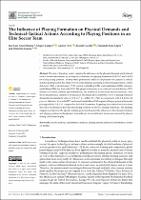Por favor, use este identificador para citar o enlazar este ítem:
https://repositorio.usj.es/handle/123456789/622
| Título : | The Influence of Playing Formation on Physical Demands and Technical-Tactical Actions According to Playing Positions in an Elite Soccer Team |
| Autor: | Arjol-Serrano, José Luis

Lampre, Miguel 

Díez, Adrián 

Castillo, Daniel 

Sanz-López, Fernando 

Lozano, Demetrio 


|
| Palabras clave : | Match analysis; Performance analysis; Physical performance; Playing system; Technical profiles |
| Fecha de publicación: | 14-abr-2021 |
| Editorial : | MDPI |
| Citación : | Arjol-Serrano, J.L.; Lampre, M.; Díez, A.; Castillo, D.; Sanz-López, F.; Lozano, D. The Influence of Playing Formation on Physical Demands and Technical-Tactical Actions According to Playing Positions in an Elite Soccer Team. Int. J. Environ. Res. Public Health 2021, 18, 4148. https://doi.org/10.3390/ ijerph18084148 |
| Resumen : | The aim of this study was to examine the differences in the physical demands and technical-tactical actions encountered by soccer players between two playing formations (1-4-2-3-1 and 1-4-4-2) for each playing position. Twenty-three professional male soccer players who played 31 official matches participated in this study. Players were classified according to their playing position: central defenders (CD), wide defenders (WD), central midfielders (CM), wide midfielders (WM), offensive midfielders (OM) and forwards (FW). The physical demands were collected as total distance (TD), distance covered in different speed thresholds, and number of accelerations and decelerations. Also, the technical-tactical variables were recorded. The results showed that the 1-4-2-3-1 playing formation demanded decelerations between 2-4 m center dot s(2) (p = 0.027; ES = 0.26) in comparison with 1-4-4-2 for all players. Likewise, forwards (FW) and central midfielders (CM) registered higher physical demands playing with the 1-4-2-3-1 compared to the 1-4-4-2 formation. Regarding the technical-tactical actions, they showed differences between the playing positions of the two playing formations. The findings suggest coaches prescribe specific training programs based on the influence of the playing formation and playing position on the physical demands and technical-tactical actions encountered by players during official match-play. |
| URI : | https://repositorio.usj.es/handle/123456789/622 |
| ISSN : | 1660-4601 |
| Aparece en las colecciones: | Artículos de revistas |
Ficheros en este ítem:
| Fichero | Descripción | Tamaño | Formato | |
|---|---|---|---|---|
| The Influence of Playing Formation on Physical Demands and Technical-Tactical Actions According to Playing Positions in an Elite Soccer Team.pdf | 373,39 kB | Adobe PDF |  Visualizar/Abrir |
Este ítem está sujeto a una licencia Creative Commons Licencia Creative Commons

